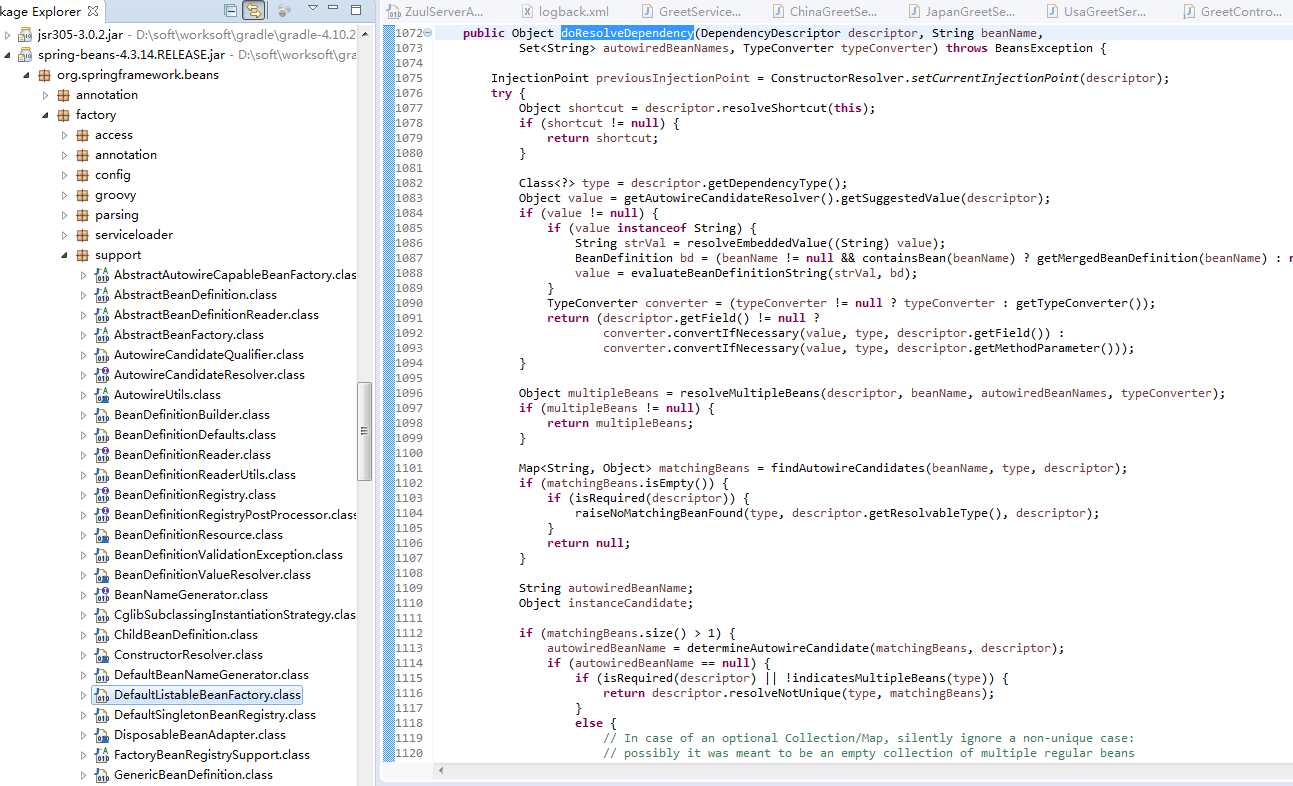一、先看一个示例演示:spring注解的一个特殊的注入功能。
首先,是定义一个接口,3个实现类。
public interface GreetService {
public String sayHello(String name);
}
@Service("china")
public class ChinaGreetServiceImpl implements GreetService {
@Override
public String sayHello(String name) {
return "你好";
}
}
@Service("japan")
public class JapanGreetServiceImpl implements GreetService {
@Override
public String sayHello(String name) {
return "亚麻得";
}
}
@Service("usa")
public class UsaGreetServiceImpl2 implements GreetService {
@Override
public String sayHello(String name) {
return "hello";
}
}
下面看到代码中有直接注入一个List和一个Map的。示例代码如下:
GreetController代码:
@RestController
@RequestMapping("/greet")
public class GreetController {
@Autowired
private List<GreetService> greetServiceList;
@Autowired
private Map<String, GreetService> greetServiceMap;
@RequestMapping(value = "/test/{id}", method = RequestMethod.GET)
public String getbook5(@ApiParam("id编号") @PathVariable("id") Long id) {
for (Map.Entry<String, GreetService> entry : greetServiceMap.entrySet()) {
System.out.println(entry.getValue().sayHello("" + id));
}
System.out.println("==list====");
for (GreetService greetService : greetServiceList) {
System.out.println(greetService.sayHello("" + id));
}
return "" + id;
}
}
最后在调试List的时候突然灵感一闪,如果只有一个对象那么List里面的值不就只有一个吗。于是开始测试验证,结果发现的确如此。当实例化一个GreetController之后,另外一个类采用泛型注入List,Spring竟然成功的将实例化的对象放入List之中。思路打开之后,针对Map的就更好说了。Spring会将service的名字作为key,对象作为value封装进入Map。
运行之后,访问http://127.0.0.1:8091/greet/test/1执行结果如下:

原来,在不知不觉中Spring已经帮我们做了很多事情,只是我们不知道而已。
二、@Autowired 注入集合类型
从spring-beans-4.3.14.RELEASE.jar的源码可以看看到如下:
在org.springframework.beans.factory.support.DefaultListableBeanFactory.doResolveDependency(DependencyDescriptor, String, Set<String>, TypeConverter) 方法中发现了原因。

对于@Autowired声明的数组、集合类型,spring并不是根据beanName去找容器中对应的bean,而是把容器中所有类型与集合(数组)中元素类型相同的bean构造出一个对应集合,注入到目标bean中。对应到上问配置文件中,就是把容器中所有类型为java.lang.String的bean放到新建的Set中,然后注入到Manager bean中。也就是把resourcePackage和resourceLoaction这两个String注入了,导致上面的输出结果。
在spring reference中也发现相关说明。
If you intend to express annotation-driven injection by name, do not primarily use @Autowired, even if is technically capable of referring to a bean name through @Qualifier values. Instead, use the JSR-250 @Resource annotation, which is semantically defined to identify a specific target component by its unique name, with the declared type being irrelevant for the matching process.
As a specific consequence of this semantic difference, beans that are
themselves defined as a collection or map type cannot be injected
through @Autowired, because type matching is not properly applicable to
them. Use @Resource for such beans, referring to
the specific collection or map bean by unique name.
@Autowired applies to fields, constructors, and multi-argument methods,
allowing for narrowing through qualifier annotations at the parameter
level. By contrast, @Resource is supported only for fields and bean
property setter methods with a single argument.
As a consequence, stick with qualifiers if your injection target is a
constructor or a multi-argument method.
从上面的说明中找到解决办法就是注入集合类型不要使用@Autowired,而使用@Resource注解。同时Spring官方也是不推荐使用@Autowired的。

